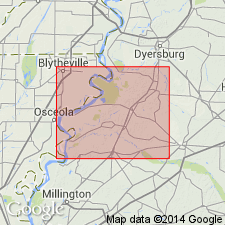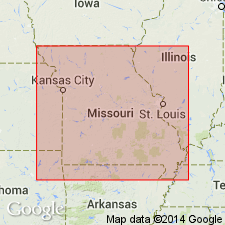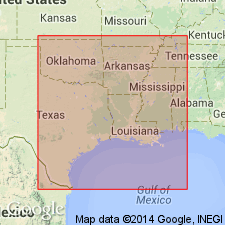
- Usage in publication:
-
- Flour Island Formation*
- Modifications:
-
- Named
- Dominant lithology:
-
- Silt
- Clay
- Sand
- AAPG geologic province:
-
- Upper Mississippi embayment
Summary:
Flour Island Formation of Wilcox Group named in Lauderdale Co., west-central TN for Flour Island No. 33, a land-tied island north of Fort Pillow. Consists of lignitic silt with interbeds of clay and sand. Thickness 60 m. Overlies Fort Pillow Sand of Wilcox Group and underlies Memphis Sand of Claiborne Group. Age is Eocene.
Source: GNU records (USGS DDS-6; Reston GNULEX).

- Usage in publication:
-
- Flour Island Formation*
- Modifications:
-
- Areal extent
- Age modified
- AAPG geologic province:
-
- Upper Mississippi embayment
Summary:
Unit is geographically extended from western TN into southeastern MO. Age changed from early Eocene to late Paleocene and early Eocene.
Source: GNU records (USGS DDS-6; Reston GNULEX).

- Usage in publication:
-
- Flour Island Formation*
- Modifications:
-
- Areal extent
- AAPG geologic province:
-
- Upper Mississippi embayment
Summary:
Flour Island Formation, Fort Pillow Sand, and Old Breastworks Formation, all of Wilcox Group, extend geographically from western TN into northeastern AR and southeastern MO. Wilcox Group overlies Porters Creek Clay of Midway Group; underlies Memphis Sand of Claiborne Group.
Source: GNU records (USGS DDS-6; Reston GNULEX).
For more information, please contact Nancy Stamm, Geologic Names Committee Secretary.
Asterisk (*) indicates published by U.S. Geological Survey authors.
"No current usage" (†) implies that a name has been abandoned or has fallen into disuse. Former usage and, if known, replacement name given in parentheses ( ).
Slash (/) indicates name conflicts with nomenclatural guidelines (CSN, 1933; ACSN, 1961, 1970; NACSN, 1983, 2005, 2021). May be explained within brackets ([ ]).

